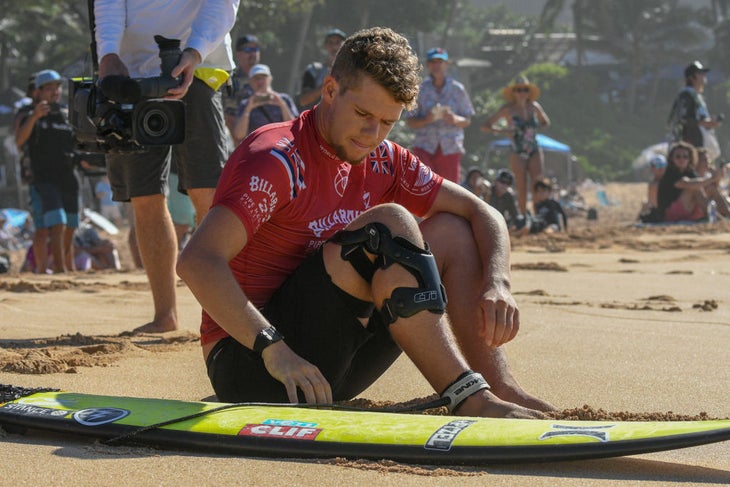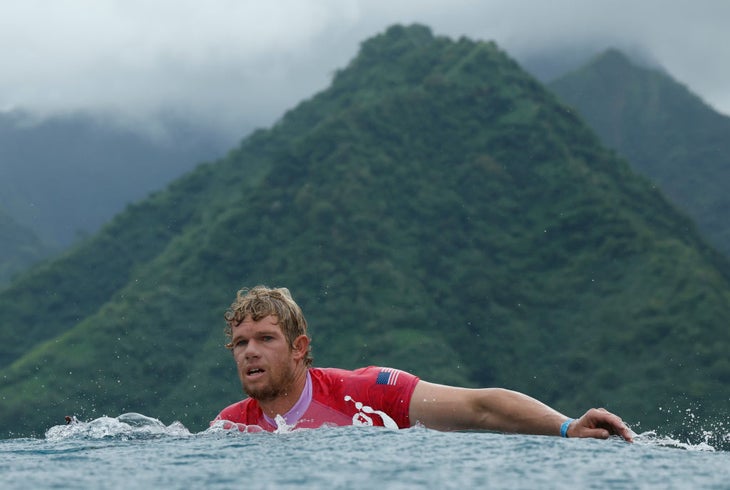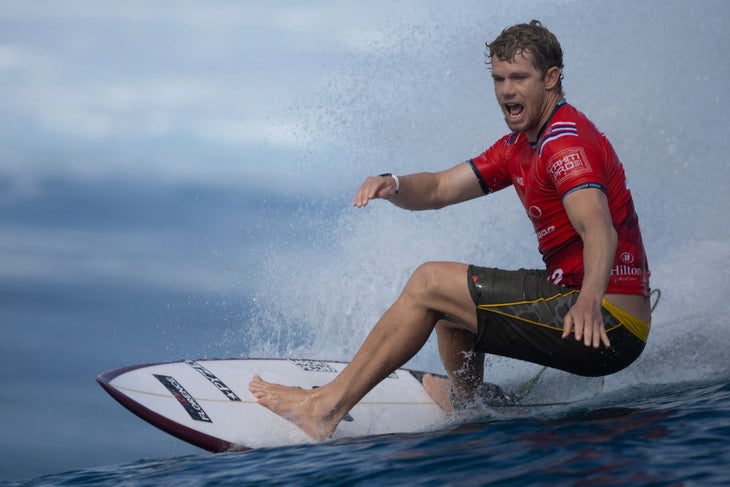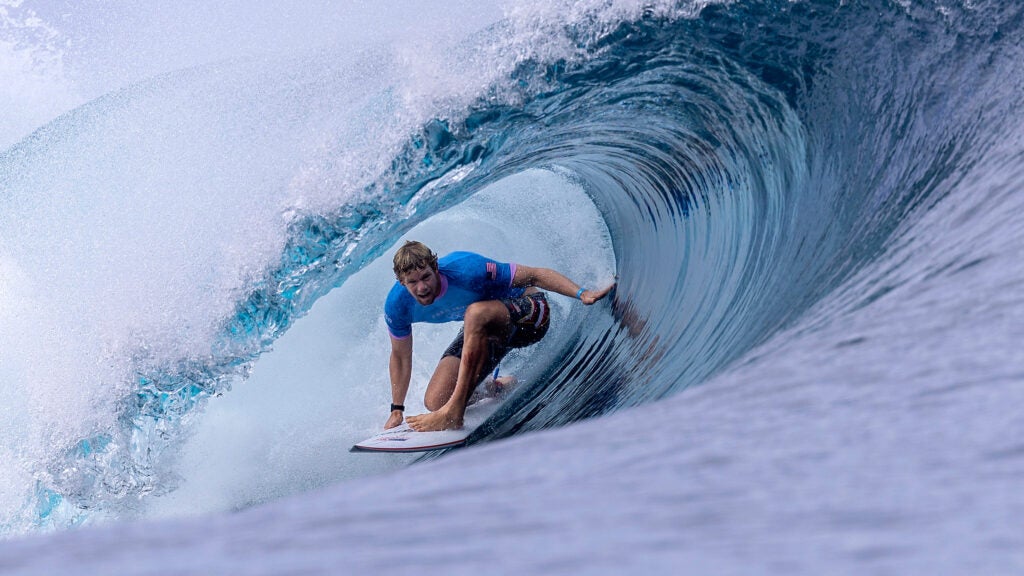No products in the cart.
Outdoor Adventure
Five Questions with John John Florence
In 2005, Hawaii’s John John Florence became the youngest surfer ever to enter the Vans Triple Crown of Surfing at age 13, which established him as the sport’s wunderkind. Florence is 31 now—older than many of his competitors on the World Surf League’s pro circuit. He’s also a new dad: Florence and his wife Lauryn Cribb welcomed their first child, Darwin, in May. And Florence is also a veteran of the painful injuries that surfing dishes out. He’s broken his back, torn the ACL in both of his knees, cracked bones in his wrist, leg, and arm, and suffered too many sprains and strains to count.
But Florence is still one of the best wave riders on the planet, and earlier this year he won his third world championship. The accomplishment, when added to his hefty trophy case, makes him one of the most decorated competitive surfers ever.
We caught up with Florence to discuss the demanding regimen that keeps him atop a field of athletes that gets younger every year.
OUTSIDE: It’s been seven years since your last world championship win. What did it take for you to achieve that this year?
Florence: It was the best journey that I could have ever imagined. There were a lot of years where it seemed like I was on my best roll, and I was like, ‘this is my year to win another one,’ and then there’d be injury after injury. But I think that’s what made this one feel so special, all that work and sacrifice and everything that went into it.
Meditation was a really big part of my whole program this year. The first thing I do when I wake up each morning is a 20-minute meditation, and then usually later in the day, I do another meditation, more of a visualization of the lead-up to a competition heat. Visualizing what it looks like an hour before a heat, and then 30 minutes before a heat, and then five minutes—down to the moment it starts. For me, I don’t necessarily love visualizing specifics in my surfing, but more the way I feel.
I visualize how I feel when I surf my best, and how it feels when I’m really enjoying myself. It’s like this kind of relaxed confidence, and I put myself there over and over and over again, seeing everything from the water to the sun to putting my jersey on to the feeling of the sand. Thinking about all that and trying to build the most real picture you can. It’s crazy how well it works.
I definitely showed up to the world championships with more intention in what I was doing. I put a lot more preparation and energy into it, and then was able to really let go and feel good. That happens a lot during the year in certain heats or events, but it doesn’t happen in every heat.
That’s what I was worried about, was showing up that day, not being in the right headspace and really nervous or anxious and that’s when I don’t surf my best or perform my best. To have gotten myself to get there for that specific heat was special.

How does your training and injury prevention differ now from when you first started?
When I first started, I didn’t do any. Now I spend a lot more time on recovery and making sure my body and my mind in the right place. I learned a lot about how much my mind has an effect on my physicality. The times I’ve been injured have been when I’ve been anxious or not wanting to be there. So now I do a lot of work behind the scenes. Almost nonstop, actually.
I do a lot of meditation and mental stuff. And then on the physical side, I like to make my training fun. I do a lot of cardio and leg work, whether it’s cycling or riding a foil board, or just things that I like to do, like hiking in the mountains. And then I do a lot of this newer stuff called Dynamic Neuromuscular Stabilization. It’s smaller movement, more functional muscle activation.
That has made me feel pretty solid in my knees and my old injuries. I’ve gotten to work with a few people over the years: Chris Prosser, Tim Brown, and Drew Morcos at MOTUS Physical Therapy here in California. Learning from them and trying to create a program for myself that makes sense. These workouts impact everything in surfing, from quicker recoveries to less soreness. I’ve had two ACL surgeries back to back. Both knees, if you don’t do anything for them, can get stiff and sore. Now I don’t even think about it. I forget that they happened. I attribute that to a lot of the work I did behind the scenes.
For recovery, I do a lot of sauna and ice. At my house I have a little recovery center. I have a float tank too, which is cool for mental training. You can fill it with Epsom salt. I also have a hyperbaric chamber. I kind of go in and out of using them based on what I’m feeling like I need. So I have a lot of little knickknacks and things

This summer you again competed in the Olympics. How was the experience different from Tokyo?
It’s funny because the first year I went to Tokyo, I came to the realization that it feels like any other event. When you’re in the water and you’re surfing and you’re competing, it feels the same, almost.
But then, when I went to Tahiti, I underestimated everything that was around the event, and I guess I didn’t really prepare myself in the best way for that. On the tour, I have my team that I travel with, and I have a lot of control over how I set up my program in and around the event. Going into the Olympics, you’re going with Team USA, and they’re setting up everything, and there’s a whole new set of people that are there helping. It’s incredible support that they gave to us down there, but it’s just different. And the Olympics – the structure around the event – is also very different; it’s much, much more structured than we’re normally used to.
Those things that were around the event made me nervous once I was there for a week. I got a little anxious about it. As a whole for surfing, it was amazing to have the waves that they got, though – other than my result, personally, I was kind of bummed.

How has being a dad changed the way you surf for fun?
My normal surfing hasn’t changed that very much. But my feeling around competing has really changed. My wife and my son were down at the finals at Trestles [in Southern California]. It was such a tense environment down there. But when I would look at my son—he’s four months old, so he’s tiny—he’d smile. For me that changed it from life or death in the finals to ‘Okay, that’s a game. This is my life. He’s my life.’ It took the pressure off in a way and made it a little more clear for me to be able to take a step back. ‘Okay, I just got to go there and surf. I know how to surf, right?’ Rather than being a little bit lost and like, ‘Oh shit. This is intense.’
What advantage do younger surfers have on the old guard in competition, in the U.S. and overseas?
Everyone just gets better and better at surfing. There’s that. And then, I think the guys are starting to take it more seriously earlier on. So these guys are coming on to the tour and learning at such a quick pace how to compete and how to wrap their mind around the events, and whether they’re meditating or training or nutrition or whatever it is, everyone’s going like, 100 percent into it. When I first got on tour, there were probably a handful of people taking it super seriously, and now it almost seems like it’s everyone. It pushes me. It pushes the sport.
This year I went all-in with nutrition and chefs and bodywork. I told myself, ‘I’m going to do everything I can.’ And you have to now, because a lot of guys are doing that. Maybe it’s the pure drive of wanting to win. Everyone wants to win so badly now.
This interview was edited for space and clarity.
Source link

